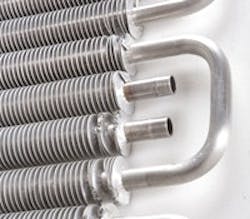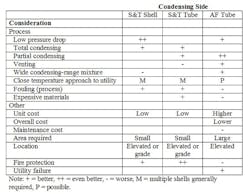Choose the Correct Condenser
Condensers remove heat to convert vapor to liquid. Process condensers shift the heat from a process stream to a utility stream, usually air or water. Utility condensers transfer the heat to a process stream from a utility stream, usually steam or hot oil. Because most engineers consider the process to be the conceptually important factor when naming equipment, the process condenser usually comes to mind first.
[pullquote]
Most often, condensers are either shell-and-tube (S&T) or air-fin (AF) exchangers. S&T units may have the process condensation on either the tube or shell side. Condensation on the shell side is much more common. Two factors drive this: pressure drop and selection of the cooling utility. Systems handling vapor usually have large volume flow rates. Placing the vapor on the shell side makes keeping pressure drop low simpler and cheaper. Corrosion concerns when using cooling water, the most popular cooling utility, nearly always favor putting the water on the tube side.
Selecting the most-effective condenser for a service depends upon both process and non-process parameters.
Table 1 shows generally accepted parameters that favor specific choices among S&T with condensing on the shell side, S&T with condensing on the tube side or AF exchangers. However, always remember that mechanical features necessary for one process requirement may make meeting other process requirements difficult. Every service must balance its competing requirements.
Table 1. Given sufficient available area and air temperatures, AF exchangers usually offer lower overall cost.
Some points merit specific comments:Close temperature approaches. Common S&T designs have temperature cross limits that prevent the process outlet temperature from being significantly lower than the utility outlet temperature. Close temperature approaches require multiple shells in series on the process or special designs. Because the air entering the bottom of an AF exchanger goes crossflow to the tubes, a sufficiently large AF exchanger can achieve a close temperature approach.Venting. Startup generally requires removing air from the unit. Also, even many total-condensing processes may accumulate trace noncondensables or upsets may bring noncondensables into the system. Vent piping is simplest for AF exchangers. Venting of S&T exchangers with shell-side condensing usually is possible with careful design. Venting of S&T exchangers with tube-side condensing is difficult.Wide condensing-range mixtures. Phase separation can occur with wide condensing-range mixtures. Once separated, the partially condensed vapor no longer may have enough heavy material present to continue condensing. This causes problems with both shell-side and tube-side condensing in multiple tube passes. All solutions to this require some combination of one-pass tube-side condensing or higher pressure drops on the shell side.Unit cost. This consists of the costs of the exchanger, structure, motor controls and utility piping inside the unit, and their installation. Typically, if cooling towers are ignored, AF exchangers usually cost more than S&T units.Fire protection. Air-fins close to the ground are difficult to protect from fires. Aluminum fins damage easily. Also, the tubes containing the process fluid may be directly exposed to flame. With sufficient elevation, this becomes less of an issue.Overall cost. This includes any cooling towers, water treating and any piping outside the unit boundary. In general, if area is available and air temperatures fit process needs, most AF units have a lower overall cost.Maintenance cost. AF exchangers have moving parts (fans), so their maintenance costs usually are higher. Also, because tubes generally only can be plugged, not replaced, on AF exchangers, maintenance costs include extra exchanger surface required to compensate for plugged tubes.Utility failure. Even with fans off, AF exchangers will work on natural draft. This draft depends upon operating conditions and resistance to flow, and can be complex to evaluate. Nevertheless, in some cases the ability to remove heat from the process even during an electrical failure that may stop cooling-water flow is important.ANDREW SLOLEY is a contributing editor for Chemical Processing. You can e-mail him at [email protected].

